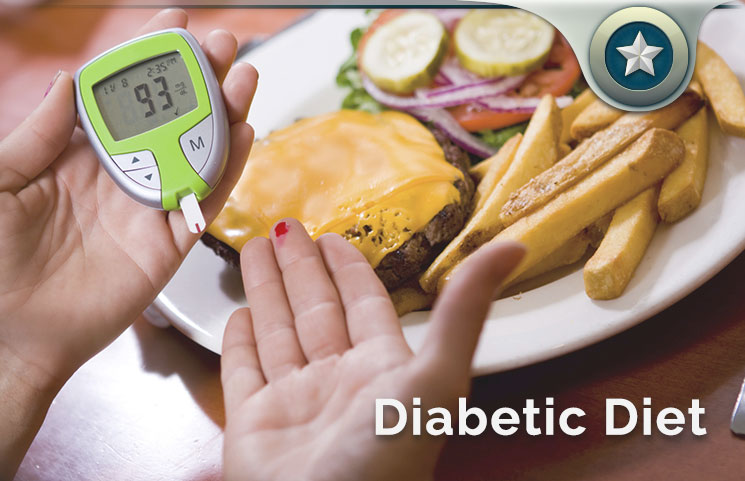A diabetic diet involves consuming the healthiest foods in moderate amounts. A diabetic plan comprises foods and drinks that are naturally high in nutrients and low in fat and calories. The important foods in the diabetic diet include fruits, whole grains, and vegetables. Individuals who are diagnosed with diabetes or prediabetes will be advised by the doctor to see a dietitian who will help design a healthy eating plan.
The goal of the diet plan is to help control the blood sugar concentration and manage the person’s weight. A diabetic plan will also help control risk factors for cardiovascular disorders such as hypertension and high blood fats. Excess consumption of calories will lead to an undesirable increase in the blood sugar concentration.
If the blood sugar level remains unchecked, it may lead to more serious complications such as hyperglycemia, damage to body organs such as the eye, heart, and kidney. The blood glucose concentration can be kept low by eating healthy foods and tracking your eating habits. Individuals with Type 2 Diabetes can usually benefit from weight loss. A diabetic diet provides you with a well-organized and nutritious way of achieving weight loss.
Diabetic Diet Details
Most foods can be included in a diabetic diet. However, some of these foods need to be eaten in moderation. Some foods are said to be “diabetes superfoods” because of their vitamin and mineral content. They are also rich in fiber, and they have minimal impact on the blood glucose level.

Foods To Eat Regularly
Healthy Carbohydrates
Sugars (simple carbohydrates) and starches (complex carbohydrates) get broken down into blood glucose during digestion. It is advisable to focus on eating healthy carbohydrates such as whole grains, vegetables, fruits, and legumes. Legumes include beans, lentils, and peas. Low-fat dairy products are also healthy for consumption.
Fiber-Rich Foods
Fiber-rich foods include foods that the body cannot break down or absorb. Foods that are rich in fiber moderate the process of digestion in the body. It also controls the blood sugar level. Foods that are high in fiber include beans, lentils, peas, fruits, nuts, whole vegetables, wheat bran, and whole-wheat flour.
Heart-Healthy Fish
Healthy experts recommend the consumption of heart-healthy fish at least twice a week. Fish is the best alternative to foods high in fats. Some of the best fish to eat include mackerel, tuna, sardines, salmon, and bluefish. These fish are rich in omega-3 fatty acids which are essential for a healthy heart.
They lower the level of triglycerides. Halibut, cod, and tuna have little-saturated fat and cholesterol content compared to poultry and beef. However, it is important to avoid fish that have a high mercurial content which includes swordfish, tilefish, and king mackerel.
Healthy Fats
Foods containing high levels of Monounsaturated and polyunsaturated fats may help reduce the levels of cholesterol in the blood. Some of the best sources of healthy fats include avocados, pecans, almonds, walnuts, and olives. Others include canola oil, olive oil and peanut oil.
Foods To Avoid
Diabetes is a risk factor for heart-related disorders because it accelerates the formation of clogged arteries and hardened arteries.
The following foods should be avoided because they can increase the risks associated with cardiovascular disorders:
Saturated Fats
Dairy products that are high in fats and animal proteins such as sausage, bacon, beef, and hot dogs should be avoided because they have a high content of saturated fats.
Trans Fats
Trans fats are present in baked foods, processed snacks, shortening and stick margarine. Diabetics should avoid these foods.
Cholesterol
Foods that are high in cholesterol include dairy products that are rich in fats and high-fat animal proteins including liver, egg yolks, and organ meats. You should not exceed 200 milligrams of cholesterol per day.
Sodium
High levels of sodium in the body may increase the risks associated with the development of heart-related disorders and stroke. It is important to regulate the amount of salt used in preparing food at home. According to health experts, the amount of sodium consumed per day should not exceed 2,300 milligrams. Individuals with hypertension should aim for less than 1,500 milligrams of sodium per day.
Creating A Diabetic Diet Plan
Several approaches can be used to come up with a healthy eating plan. The dietitian will recommend one or more of the following methods for a diabetic:
1. Counting Carbohydrates
Foods that are high in carbohydrates have a significant impact on the blood glucose level. Carbohydrates get broken down to glucose which may increase the blood sugar concentration.
It is advisable to consume the same amount of carbs each day at regular intervals to help regulate blood sugar level. A dietitian should teach the patient how to check food portions. People with diabetes who are on insulin should be taught how to count the carbohydrate content in each meal and snack and adjust the insulin dose as required.
2. The Plate Method
The American Diabetes Association provides individuals with a simple method for planning meals. The method is focused on consuming vegetables. According to the plate method, you should fill one half (1/2) of your plate with non-starchy vegetables such as carrots, spinach, and tomatoes.
One quarter (1/4) of the plate should be filled with protein-rich foods such as lean pork and tuna. The final quarter (1/4) should be filled with starchy food and whole-grain foods. You can also add a serving of dairy or fruit together with a drink of water.
3. The Exchange Lists System
A health expert may also recommend an exchange lists system to a diabetic. Foods in this category include proteins, carbohydrates, and fats. One serving in one category is known as a “choice.” A meal choice consists of about equal amounts of proteins, fats, carbohydrates, and calories. They all produce the same effect on the blood glucose level.
4. Glycemic Index
Diabetics may use the glycemic index to choose foods, especially carbohydrates. The glycemic index ranks foods high in carbohydrates based on their impact on the blood sugar level. Individuals who follow this method select foods that have the lowest glycemic index. Foods that have a high glycemic index are avoided.
Diabetic Diet Final Thoughts
People with diabetes should partner with their health care providers and dietitians to design an eating plan that is suitable for them. A proper diabetic diet should contain healthy foods that will help control blood sugar levels. If you stray from following the prescribed eating plan, you risk serious health complications.









